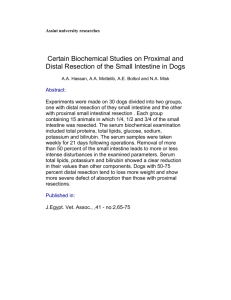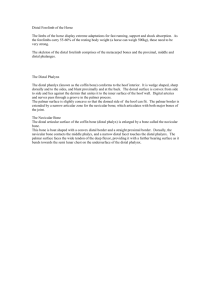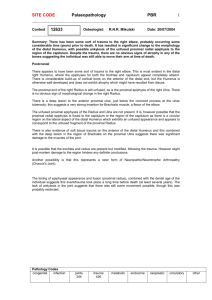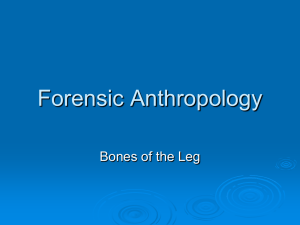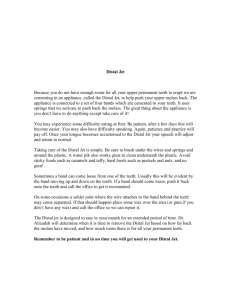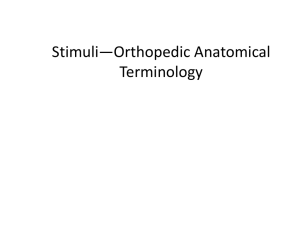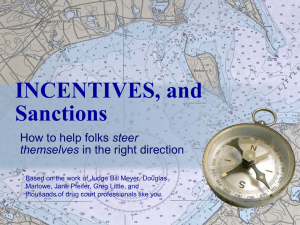A NEW FAMILY OF THEROPODA
advertisement
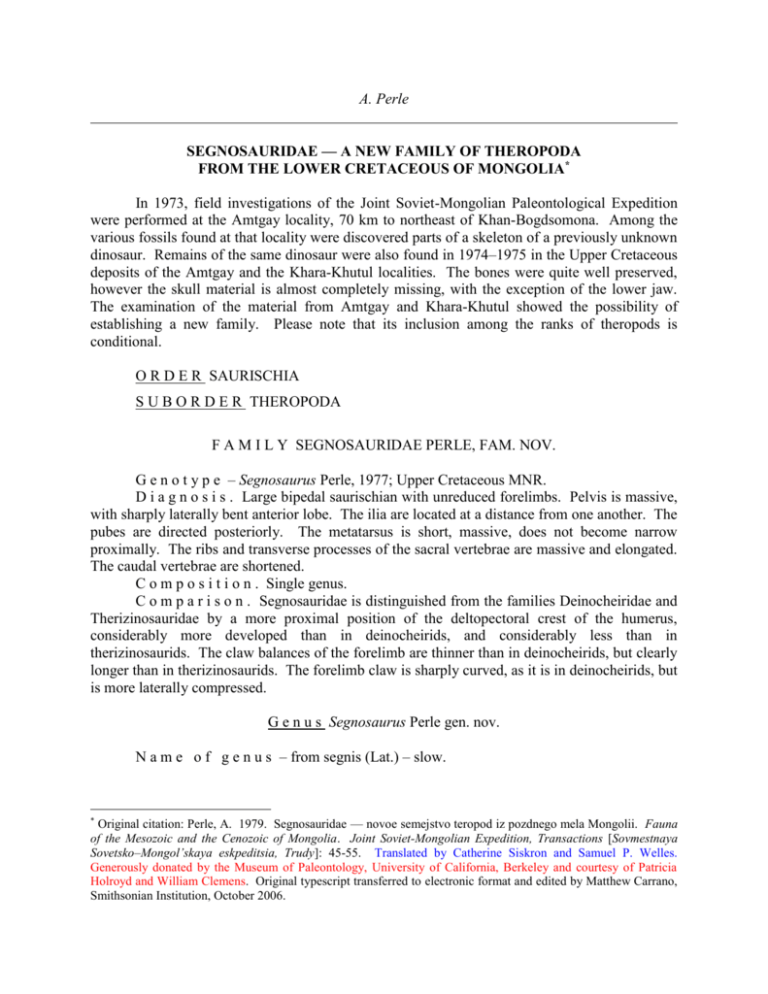
A. Perle SEGNOSAURIDAE — A NEW FAMILY OF THEROPODA FROM THE LOWER CRETACEOUS OF MONGOLIA* In 1973, field investigations of the Joint Soviet-Mongolian Paleontological Expedition were performed at the Amtgay locality, 70 km to northeast of Khan-Bogdsomona. Among the various fossils found at that locality were discovered parts of a skeleton of a previously unknown dinosaur. Remains of the same dinosaur were also found in 1974–1975 in the Upper Cretaceous deposits of the Amtgay and the Khara-Khutul localities. The bones were quite well preserved, however the skull material is almost completely missing, with the exception of the lower jaw. The examination of the material from Amtgay and Khara-Khutul showed the possibility of establishing a new family. Please note that its inclusion among the ranks of theropods is conditional. O R D E R SAURISCHIA S U B O R D E R THEROPODA F A M I L Y SEGNOSAURIDAE PERLE, FAM. NOV. G e n o t y p e – Segnosaurus Perle, 1977; Upper Cretaceous MNR. D i a g n o s i s . Large bipedal saurischian with unreduced forelimbs. Pelvis is massive, with sharply laterally bent anterior lobe. The ilia are located at a distance from one another. The pubes are directed posteriorly. The metatarsus is short, massive, does not become narrow proximally. The ribs and transverse processes of the sacral vertebrae are massive and elongated. The caudal vertebrae are shortened. C o m p o s i t i o n . Single genus. C o m p a r i s o n . Segnosauridae is distinguished from the families Deinocheiridae and Therizinosauridae by a more proximal position of the deltopectoral crest of the humerus, considerably more developed than in deinocheirids, and considerably less than in therizinosaurids. The claw balances of the forelimb are thinner than in deinocheirids, but clearly longer than in therizinosaurids. The forelimb claw is sharply curved, as it is in deinocheirids, but is more laterally compressed. G e n u s Segnosaurus Perle gen. nov. N a m e o f g e n u s – from segnis (Lat.) – slow. Original citation: Perle, A. 1979. Segnosauridae — novoe semejstvo teropod iz pozdnego mela Mongolii. Fauna of the Mesozoic and the Cenozoic of Mongolia. Joint Soviet-Mongolian Expedition, Transactions [Sovmestnaya Sovetsko–Mongol’skaya eskpeditsia, Trudy]: 45-55. Translated by Catherine Siskron and Samuel P. Welles. Generously donated by the Museum of Paleontology, University of California, Berkeley and courtesy of Patricia Holroyd and William Clemens. Original typescript transferred to electronic format and edited by Matthew Carrano, Smithsonian Institution, October 2006. * T y p e s p e c i e s – Segnosaurus galbinensis sp. nov.; Bayn Shire suite of southeastern Gobi. D i a g n o s i s . Lower jaw is long and thin, the teeth are closely positioned. The anterior teeth are morphologically similar to the teeth of theropods, but are much smaller than the teeth of carnosaurs. The posterior teeth are straight, slightly pointed, less laterally compressed, and sharply reduced in size in comparison with the preceding teeth. The scapulocoracoid is massive, fused. The deltopectoral crest of the humerus is prodigally developed. The phalanges are dorsoventrally flattened. Their lateral articular depressions were practically not developed. The claw of the first digit of the forelimb is sharply curved, pointed and laterally compressed. The anterior “wings” of the ilia are quite broad, the posterior are short and have massive thickening on the posterodorsal surface. The pubic symphysis is vertically broad. The ischium is flat, its obturator process is distally displaced and anteriorly articulates with the posterior edge of the pubis. The ascending process of the tibia overlaps the fibula and articulates with the calcaneum by means of a mobile articulation. The metatarsus consists of four (with the exception of the fifth) functioning support elements. S p e c i e s c o m p o s i t i o n . Monotypic. D i s t r i b u t i o n . Upper Cretaceous, Bayn Shire suite, southeastern Gobi, MNR. Segnosaurus galbinensis Perle. sp. nov. N a m e o f s p e c i e s from the Galbin region of the Gobi. H o l o t y p e – No. 100/80, PST GIN AN MNR; lower jaws, incomplete humerus, complete radius and ulna, separate phalanges of digits and a forelimb claw, almost complete pelvis, incomplete right femur, 6 sacrals, 10 anterior caudals, 15 posterior caudals, first abdominal rib, fragments of dorsal ribs; MNR, southeastern Gobi, Amtgay, Khara-Khutul localities, Bayn Shire suite of the Upper Cretaceous. M a t e r i a l . In addition to the holotype, fragments of postcranial skeletons of two specimens. Paratype No. 100/82 PST; femur, tibia, fibula, tarsus, separate phalanges of digits and a claw, rib fragments, complete ilia, proximal part of ischium, and the distal part of pubis. Paratype No. 100/83 PST; scapulocoracoid, radius, ulna, and separate forelimb bones. D e s c r i p t i o n . The lower jaw (fig. 1) is relatively low, elongated, constructed too lightly for a carnosaur (Maleyev, 1955; Gilmore, 1920; Osborn, 1912). The dentary is elongated, narrow, highly laterally compressed. The dorsal edge of the anterior part is curved ventrally, while the ventral edge is moderately flat. On the posterolateral surface of the bone stands out a sharply expressed convexity that reaches the contact with the surangular. Along the dorsal edge are located the alveoli of 25 teeth, which occupy approximately 65% of the length of the dentary. The thin interdental plates form alveolar partitions, which are slightly broader internally. The ventrally curved anterior part of the jaw is not characteristic of theropods, but the type of structure and the shape of the teeth is still reminiscent of the latter. The surangular is long, sword-like in shape, and has a grooved articulation with the dentary. The lower, flat edge forms the upper part of the elongated-oval posterior mandibular opening, too large and elongated for theropods. Laterally the surangular is insignificantly widened. The internal surface of the bone is sharply curved . The angular is adjacent to the external surface posterior to the posterior mandibular fenestra. The posterior end is fused with the prearticular internally. The absence of an additional opening and the presence of a rather elongated posterior mandibular fenestra do not correspond to the structure of the surangular in carnosaurs (Maleyev, 1974; Russell, 1970). The angular is wing-like in shape. Anteriorly it narrows gradually and wedges between the dentaries and splenial, in the center part it becomes insignificantly thicker. Its posterior end reaches almost to the very end of the articular. The medial surface is concave, whereas the external is convex in the center. The posterior end of the bone broadens vertically and comprises half of the overall height jaw. The prearticular is narrow and curved. Ventrally it articulates with the angular and forms the posteroventral border of the jaw from the internal side. It forms the ventral edge of the adductor cavity. The posterior part of the bone is straight, the anterior is sharply turned dorsally and broad distally. The posterior edge is connected to the surangular by means of a meandering suture on the level of the lower edge of the posterior mandibular fenestra. The splenial is very thin, triangular in outline, adjoins the inner side if the dentary and forms the anterior edge of the posterior mandibular fenestra. Its ventral part is insignificantly thicker and has even sides. Teeth. On each jaw ramus are located 24 (25?) teeth. The lateral surface of the teeth is slightly convex. The anterior teeth are slightly crooked posteriorly and narrow considerably toward the top. The crowns are slightly concave on the internal surface near the base of the tooth. The anterior surface is convex, the serrated edges are located somewhat at a slant on the labial and lingual surfaces. The first 12 (13?) teeth are very highly laterally compressed and appear higher and more elongated than those that follow. The teeth are closely set, without intervals. On the internal side of the 21st tooth a third side is weakly expressed with 6–8 serrations, unequal in size. The anterior serrations are usually larger than posterior. Their number over 5 mm: 8–10 on the anterior edge, 9–11 on the posterior. From the medial edge at the base of several teeth, small alternating teeth are found in the alveoli, the more centrally located alveoli are below the functioning teeth. Postcranial Skeleton The scapula (fig. 2) is straight, proximally flat. The acromial process is clearly expressed and elongated along the entire contact with the coracoid. The dorsal and ventral edges of the scapula are almost parallel. The lower distal end of the scapula forms the major part of the glenoid cavity, directed posteriorly. The suture between the scapula and the coracoid is fused. The coracoid is very wide, rectangular in outline. It is visibly thicker in the middle. The anterior edge is evenly flat and moderately curved medially. The place for the attachment of the m. coracobrachialis is clearly designated by a tubercle. The coracoid foramen is not large, located near the suture with the scapula. The forelimbs of Segnosaurus are relatively short. They comprise 69% of the length of the limbs of Deinocheirus, 73% — Therizinosaurus, excluding the length of the metacarpals and ungual phalanges (Osmólska & Roniewicz, 1970; Barsbold, 1976a). The humerus (fig. 3) is massive. The proximal part is transversely flat and proximally curved. The deltopectoral crest is displaced proximally, its surface is even. The shaft is subcylindrical, slightly concave externally. The distal end of the bone is transversely wide. The condyles for articulation with the radius and ulna are well-defined, the intercondylar fossa is moderately deep. The deltopectoral crest of the humerus is less developed than in Therizinosaurus (Ostrom, 1969; Russell, 1970) and in saurornithoidids (Osborn, 1924; Barsbold, 1974), whereas in Chilantaisaurus the same crest is particularly well-developed and located more distally (Hu-Show-Young , 1964). The radius is a massive bone. Its length comprises approximately 60% of the length of the humerus. The proximal part is flat laterally, the articular surface is concave along the center and convex along the sides. The shaft is straight. The distal articular surface is convex. The ulnar surface is even and slightly rough at the place of contact with the radius. The ulna is thicker than the radius and slightly longer. It comprises approximately 70% of the humerus. The proximal articular surface is slightly laterally concave. The articular surface for the condyle of the humerus is concave and dorsoventrally elongated. The shaft is insignificantly twisted along its axis in the middle. The ulnar process is well-developed. The ungual phalanges. The phalangeal formula is unknown, because only the phalanx of the first digit of the left forelimb, supposed first and second phalanges of the second digit, and the ungual phalanx of the third digit were found. The supposed phalanx of the first digit is long, thin, moderately dorsoventrally compressed. The ventral surface is flat in the middle. The distal end is vertically wide. The articular condyles are flat laterally and have a rounded shape. The lateral articular depressions are weakly expressed. The proximal part of the phalanx is massive and wide, the articular surface is rounded. The first and second phalanges of the second digit were found articulated. They are short, dorsoventrally flat. Their ventral surface is slightly concave. The ungual phalanx of the third digit is somewhat longer than the second phalanx and is quite flat transversely. The ungual is sharply curved, very pointed and compressed laterally. Its ventral tubercle for the attachment of the flexor tendons is thick and massive. Pelvic girdle (figs. 4, 5) The ilium has an anterior lobe that is bent ventrolaterally. Dorsally both ilia are separated from one another. Lateral concavity is clearly expressed. The pubic process is noticeably flat in the anteroposterior direction and distally it narrows sharply. Its anterior surface is convex. The posterior lobe of the ilium is short and very thick. It is possible that its thickness is an analog of the antitrochanter of ornithischian dinosaurs. The acetabulum is open, rounded. The ischial process is short and massive. The pubis is elongated, laterally flat. The distal broadening is well-defined but not typical for Late Cretaceous dinosaurs. It is less pointed and wider than in carnivorous dinosaurs. The shaft is evenly flat from the sides, and it is oval in cross-section. The length of the medial crest of the shaft comprises more than 2/3 the length of the pubis. The pubes are directed posteroventrally. The ischium is highly laterally compressed. The distal part is thick and narrows toward the end. The shaft is very thin, in the middle it is insignificantly thicker. The obturator process is considerable in size, located unusually distally. The proximal end of the bone is wide and thick. It forms two well-defined processes that are used for the attachment of the posterior process of the pubis and the foot of the ilium. The posteriorly shortened pelvis is not characteristic for a carnosaur (Colbert, 1964). Nevertheless the dorsally diverging ilia of Segnosaurus are located almost analogously to the ilia of Velociraptor and Oviraptor (Osborn, 1924). The somewhat posteriorly directed pubis of Segnosaurus is analogous to pelvic elements of dromaeosaurids (Barsbold, 1976b) and even Archaeopteryx (Ostrom, 1972), but the distal broadening is directed anteriorly, as it is in later Jurassic and Cretaceous carnosaurs (Gilmore, 1920; Russell, 1970). Hind limbs The femur is straight. Distal condyles are clearly defined. The intercondylar fossa is deep. The shaft has an oval shape in cross-section. The fourth trochanter is located a little above the middle of the shaft. Its basal surface is concave. The lesser trochanter is thick, and separated by means of a deep notch from the greater. The greater trochanter is massive and its dorsal surface is slightly concave anteriorly. The head of the femur rests on a long neck. The tibia (fig. 6) is straight, a little shorter than the femur, and twisted along its axis. The distal part gradually broadens transversely. The anterior surface is distally flat and concave. The proximal articular surface has a triangular shape, is slightly concave along the center, and rough. The lateral articular tubercle for articulation with the fibula is well-developed. The cnemial crest is well-defined, projects anteriorly and slightly interiorly. The fibula is long, narrows distally, its proximal articular surface is rough and convex. Along most of the length the bone is adjacent to the tibia. On the anterolateral surface of the middle part of the shaft there is a large thickening. The tarsus consists of four bones; astragalus and calcaneum of the proximal row and flat, angular bones of the distal. The astragalus is massive, with a thin elongated ascending process. The latter is square: wide at the base, but narrowing suddenly toward the top. The external edge is crooked, its top is slanted in the direction of fibula. The calcaneum is massive, the vertical diameter surpasses the anteroposterior. Has a mobile articulation with the astragalus. The distal elements of the pes are flat, disc-shaped, quite varied in size. They are located on different levels along the proximal surface of metatarsals III and IV. The posterolateral edges of the pre-metatarsal bones are thick, whereas the anteromedial are thinner. The third premetatarsal is much smaller in relation to the fourth. The metatarsus (fig. 7) consists of five bones; only four of them are functional as support elements. A metatarsus as short as that of Segnosaurus has not been previously encountered among theropods. Its length comprises 30% of the length of the tibia. Externally it looks like the metatarsus of a prosauropod, but in size is much larger. The length of Mt III of Lufengosaurus is 185 mm, in Segnosaurus it is 275 mm. At the same time the proximal part of the first element of the metatarsus is morphologically far from corresponding to the metatarsal elements of prosauropods (Young, 1951). Metatarsal I is quite short and diverges distally from the second element of the metatarsus. The proximal part is laterally quite concave. The distal articular surface is moderately convex. The general direction of the first bone of the metatarsus is anterolateral. Metatarsal II has massive epiphyses, trapezoidal in outline. The lateral and medial condyles of the distal end are well-defined, they are separated by a ventral depression. Metatarsal III is insignificantly longer than the second. It is proximally flat below. The articular surface is convex. The shaft is laterally compressed and twisted along the axis. Distal condyles are well-defined, with expressed lateral articular depressions. Metatarsal IV is of equal length to the third. Proximally it is quite broad transversely, the articular surface at this end is moderately convex. Shaft is flattened dorsoventrally. The distal articular surface is convex. Metatarsal V is highly reduced and has no functional significance. Pedal phalanges. The first digit of the left hind limb is the shortest in relation to the three others, but functionally had equal significance to them. The phalanges are not morphologically distinct from phalanges of carnivorous theropods. The lateral articular cavities are moderately deep. The proximal articular surface is slightly concave. On all the basal phalanges these peculiarities are developed to the same extent. The ungual is massive, sharply curved, flat laterally, and more pointed than in prosauropods. The proximal articular surface is slightly convex in the middle. The ventral tubercle for attachment of the flexor ligaments is massive. Vertebral column The sacrum consists of six firmly fused vertebrae. Their centra are broadened transversely and are relatively elongated. The length of the centrum of the vertebrae is insignificantly greater than the width. The transverse processes are elongated, moderately upcurved, ventrally are connected with the thick sacral ribs. Their distal ends are firmly fused with the medial surface of the ilia, creating an immobile articulation of the body with the vertebral column. The neural spines are not very long, slightly extended anteriorly in the anteroposterior direction. In height they surpass the level of the dorsal edges of the ilia. The tops of the spines are coarsely rough, articulated with each other into a longitudinal vertical plate. The first ten caudal vertebrae were preserved in an articulated state with the sacrals. Some separate vertebrae from the distal end of the tail were taken from the same place where the pelvis was found. The proximal caudal vertebrae are massive, high and moderately laterally compressed. The neural arch is 1ow, with a small neural canal. The prezygapophyses are welldeveloped, directed dorsomedially, widely spaced. The articular facets of the postzygapophyses are in contrast closely spaced, directed ventrally and laterally. The distal caudal vertebrae are platycoelous, with short, massive centra. On the anteroventral surface of the vertebral centra are located peculiar small projections, to which correspond small depressions on the posterior surface of the preceding vertebra. Haemal processes are straight, V-shaped, extended dorsoventrally. The distal ends of the processes are quite flat laterally and insignificantly curved posteriorly. Ribs. The tubercle of the rib is elongated, projects anteriorly in the anterior ribs, whereas in the posterior it is sharply reduced. The articular surface of the tubercle is slightly convex and is oval shaped, the dorsoventral diameter is the greatest. The proximal wide part of the rib below the tubercle is noticeably elongated anteriorly. The neck of the capitulum of the rib is slightly curved up and increases in length on the posterior ribs. The abdominal ribs are represented by a single, bilaterally pointed central rib. Its internal angle is no greater than 95°. Lateral branches are elongated and narrow, rounded in crosssection. The distal ends are curved up. G e o l o g i c a g e . Upper Cretaceous, Bayn Shire suite. L o c a l i t y . Amtgay, Khara-Khutul, southeastern Gobi, MNR. B o n e m e a s u r e m e n t s of Segnosaurus galbinensis, in mm. Lower jaw, No. 100/80 PST Maximal length Anteroposterior diameter of posterior mandibular fenestra 420 60 Dorsoventral diameter of posterior mandibular fenestra Length of the alveolar part of the dentary Height of the dentary at the point of contact w/surangular 17 160 56 Pelvis, No. 100/80 PST Ilium Acetabulum Ischium 750 175 650 155 — — — — — Maximal length Length of pubic process Length of distal symphysis Pubis 750 — 365 Hind limbs, No. 100/82 PST Maximal length Anteroposterior shaft diameter Proximal transverse shaft diameter Distal transverse shaft diameter Maximal height Femur 840 155 — 270 — Tibia 860 97 195 260 — Fibula 765 35 50 18 — Astragalus — — 195 230 Metatarsal elements, No. 100/82 PST Maximal length Width of distal articular surface Width of proximal articular surface Height of distal articular surface Height of proximal articular surface mt I 145 70 32 60 80 mt II 218 76 65 65 103 mt III 274 80 68 68 102 mt IV 266 80 110 58 80 Forelimb elements, No. 100/83 PST Maximal length Transverse diameter of proximal end Transverse diameter of distal end Minimal shaft diameter Humerus 560 200 145 56 Radius 335 38 48 32 Ulna 390 70 45 33 Measurements of the phalanges of the second digit of the forelimb, No. 100/80 PST Length Shaft diameter Width of distal end Height of proximal end53 1st phalanx 99 23 47 43 2nd phalanx 100 25 38 54 ungual 195 — — First ungual phalanx of the hind limb, No. 100/82 PST I 82 48 62 44 Maximal length Width of distal articular surface Width of proximal articular surface Transverse shaft diameter Maximal length of ungual – 160 Height of proximal articular surface of ungual – 44 II 88 61 65 48 LITERATURE (Not listed.) III 88 58 75 53 IV 51 54 64 58 FIGURE CAPTIONS Fig. 1. Segnosaurus galbinensis gen. nov., sp. nov. Specimen No. 100/80 PST; lower jaw, medial view; MNR, southeastern Gobi, Bayn Shire suite of the Upper Cretaceous. An – angular, Sa – surangular, De – dentary, Spl – splenial, Pr.Ar. – prearticular, Po.F. – posterior mandibular fenestra, In – interdental plates, Mcc – Meckelian canal, Pco.c – posterior coronoid. Fig. 2. Segnosaurus galbinensis gen. nov., sp. nov. Specimen No. 100/83 PST; scapulocoracoid, lateral view; MNR, southeastern Gobi, Bayn Shire suite of the Upper Cretaceous. Sc – scapula, Co – coracoid, Co.F – coracoid foramen, Gl – glenoid cavity. Fig. 3. Segnosaurus galbinensis gen. nov., sp. nov. Specimen No. 100/83 PST; humerus, dorsal view; MNR, southeastern Gobi, Bayn Shire suite of the Upper Cretaceous. Fig. 4. Segnosaurus galbinensis gen. nov., sp. nov. Specimen No. 100/83 PST; pelvis, lateral view; MNR, southeastern Gobi, Bayn Shire suite of the Upper Cretaceous. Il – ilium, Pu – pubis, Is – ischium, Ac – acetabulum. Fig. 5. Segnosaurus galbinensis gen. nov., sp. nov. Specimen No. 100/80 PST; pelvis, dorsal view; MNR, southeastern Gobi, Bayn Shire suite of the Upper Cretaceous. Il – ilium, Sa – sacrum, N.Pr – neural spine, Il.pr. – pubic peduncle of ilium, Is.pr. – ischial peduncle of ilium. Fig. 6. Segnosaurus galbinensis gen. nov., sp. nov. Specimen No. 100/82 PST; tibia, anterior view; MNR, southeastern Gobi, Bayn Shire suite of the Upper Cretaceous. As – astragalus, Ca – calcaneum, Cn.pc. – cnemial crest*. Fig. 7. Segnosaurus galbinensis gen. nov., sp. nov. Specimen No. 100/82 PST; metatarsus, anterior view; MNR, southeastern Gobi, Bayn Shire suite of the Upper Cretaceous. Mtt – metatarsals, Ta.D.III/IV – distal tarsals III/IV, Fal – phalanges, Un – ungual. * sic: fibular crest – MTC.

